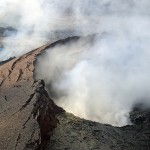

Rumblings under Alaska’s Pavlof Volcano have diminished, but scientists are keeping an eye on the state’s most active volcano in case it sends up another ash cloud.
The volcano sent an ash plume to 22,000 feet Monday, and it drifted east about 50 miles, prompting the Alaska Volcano Observatory to raise the aviation warning in the area to red, the highest level.
By Tuesday, the cloud was below an altitude of 20,000 feet. The observatory Tuesday night lowered the warning back to orange, from “warning” to “watch,” after 12 hours of lower tremors.
The eruption plume had split into two parts, and the higher plume was mostly steam and gas with little ash that could threaten aircraft, the observatory said.
The 8,262-foot Pavlof Volcano is 625 miles southwest of Anchorage on the Alaska Peninsula, the finger of land extending southwest from the mainland toward the Aleutian Islands. Pavlof is a conical volcano, nearly symmetrical, a giveaway that its eruptions tend to be less violent than the kind that blows the tops off mountains, said Game McGimsey, a volcanologist at the observatory.
 “We call them Fuji-style structures,” he said, after Japan’s Mount Fuji.
“We call them Fuji-style structures,” he said, after Japan’s Mount Fuji.
Pavlof also erupted last year. The last ash plume was June 26.
The event over the weekend was unusual because scientists did not initially detect elevated seismicity below the mountain. Instead, scientists using satellite signals detected elevated surface temperatures late Friday afternoon.
A lava flow began from a vent on the north side of the mountain a few hundred meters from the peak, and scientists began to see plumes heading to the east and northeast at 9,000 to 10,000 feet.
“What was going on was lava fountaining at the surface, which was creating a spatter collar around the vent,” McGimsey said.
Gas bubbles rose through the mountain’s conduit and burst at the surface, he said. The gas blasts lava into pieces, and ash-size pieces are carried off in the wind.
That continued Sunday with subtle seismicity masked by noise from the flows of lava, mud and water over ice on the north flank of the mountain.
Around 3 p.m. Monday, there was a considerable uptick in seismicity, McGimsey said. The volcano sent its ash plume above 20,000 feet, and the observatory increased the aviation warning to red.
From midnight to 3 a.m. Tuesday, seismicity and plumes diminished.
McGimsey said it’s difficult to tell how much ash was in the plume, but no communities recorded ash fall.
The observatory warned that with an ongoing eruption, conditions could change rapidly.